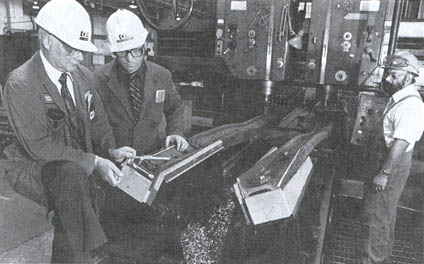
Volume 14
Number 16
Dec. 5, 1984
|
 |
Jig Installed in Winnipeg Saves Time,
Equipment
By Ken Emmond

In operation: Area Supervisor Bill Odger (left)
and Frog Shop Analyst Alf Prideaux inspect the flare cut on a piece of rail. Operating the new machine is
machinist Agit Ramgotra (right). The jig stands are bolted to a table while the cutters mill steel off the
rail. The steel section between the rail and the metal base is interchangeable so it can be fitted with any
of four rail weights.
Winnipeg - It's a simple enough structure, now that
it's in place.
But for Bill Odger and Alf Prideaux there were a lot of headaches in designing the sturdy foundation built
to hold a rail steady while carbide-face mill tools remove the steel to the flare cut
specifications of a railway frog.
WHAT IS A FROG?
A definition of a frog would be the track structure used at the intersection of two tracks to provide
support for wheels and passageways for their flanges, permitting wheels on either track to cross to the
other.
There is no doubt about the success of the venture.
DOLLARS SAVED
"We saved a lot of dollars just in planer tools alone", said Mr. Odger, area supervisor at CP
Rail's only frog shop.
"The biggest problems were the compound angle and making it rigid enough", said Mr. Prideaux,
frog shop analyst, Weston Shops.
Both employees have been working to perfect their new "jig" for more than a year.
According to the specifications of a frog, the rail must be cut at precisely 25 degrees off the horizontal
plane. This provides the necessary wheel flange clearance so that switching can be performed smoothly.
The "flare cut" used to be a time consuming operation. The conventional planing method required
the operator to measure his angles carefully as he slowly machined the rail.
He could only cut one rail at a time, and the high-speed steel planing tools were in constant
need of sharpening.
TWO AT A TIME
Now, aided by the new jig, a machinist operating a mill planer can mill steel off two rails at one time. It
has two cutting heads and the operator can go for hours without changing the carbide cutting tools.
The cutting heads are indexable, meaning that each of the eight cutting edges can be rotated to shave the
steel rail before the tool must be replaced.
The cutters can usually be used for an entire shift before the cutting heads are replaced.
DIRECT SAVINGS
In addition, the work is done in a fraction of the time it used to take.
The jig that holds the rail in place is sturdily built to prevent vibration. A removable section enables the
operator to use it for four gauges of rail; 100-pound, 115-pound,
132-pound, and 136-pound.
This year the frog shop will produce more than 900 wing and point rails and about 610 guard rails. The jig
will result in direct savings of about $22,000 a year.
This CP Rail News article is copyright
1984 by Canadian Pacific Railway and is reprinted here with their permission. All photographs, logos, and
trademarks are the property of the Canadian Pacific Railway Company.

16 January 2002
Canadian Pacific Frog Shop to Croak in May
Canadian Pacific today said it will close its Lethbridge (Alberta) Frog Shop in May.
In conjunction with the shop closure, eight positions will be eliminated and an additional 12 positions
currently based at the shop will be relocated to adjacent CP facilities in Lethbridge.
The shop produces second-hand frogs for use on CPR's network. In the future, the railway
intends to purchase new frogs from third-party manufacturers, which it says is more
efficient.
|
|